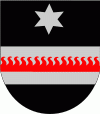Sodankylä
 |
The municipality has a population of 0, which makes it the fourth largest municipality in Lapland after Rovaniemi, Tornio and Kemi, and at the same time the largest municipality in population that does not use the title of city or town. It covers an area of undefined km2 of which undefined km2 is water, making it the second largest municipality in Finland in terms of area, right after its neighboring municipality of Inari. The population density is undefined PD/km2.
Sodankylä has an airfield. Also, one of EISCAT's scientific radar receiver stations is located outside Sodankylä, at the site of the Sodankylä Geophysical Observatory. The urban area around the observatory is known as "Tähtelä", which translates as "Place of Stars", although the observatory does not observe stars. The Jaeger Brigade of the Finnish Army is also located in Sodankylä. Although the name "Sodankylä" and (also "Soađegilli") directly translate to "Village of War", the etymology of the name is from a surname Sova rather than the word "war".
Since 1986, Sodankylä has been home to the Midnight Sun Film Festival (Sodankylän elokuvajuhlat).
* Sodankylä Local History Museum
* The Old Church (made 1689 of wood), The New Church (made 1859 of stone)
* Tankavaara, gold museum, gold village
* Ilmakkiaapa peatland protection area (35 km north)
* Urho Kekkonen National Park (Koilliskaira Visitor Centre)
* Luosto – a hill home to the only open amethyst mine in Europe
Map - Sodankylä
Map
Country - Finland
 |
 |
| Flag of Finland | |
Finland was first inhabited around 9000 BC after the Last Glacial Period. The Stone Age introduced several different ceramic styles and cultures. The Bronze Age and Iron Age were characterized by contacts with other cultures in Fennoscandia and the Baltic region. From the late 13th century, Finland became a part of Sweden as a consequence of the Northern Crusades. In 1809, as a result of the Finnish War, Finland became part of the Russian Empire as the autonomous Grand Duchy of Finland, during which Finnish art flourished and the idea of independence began to take hold. In 1906, Finland became the first European state to grant universal suffrage, and the first in the world to give all adult citizens the right to run for public office. After the 1917 Russian Revolution, Finland declared independence from Russia. In 1918, the fledgling state was divided by the Finnish Civil War. During World War II, Finland fought the Soviet Union in the Winter War and the Continuation War, and Nazi Germany in the Lapland War. It subsequently lost parts of its territory, but maintained its independence.
Currency / Language
| ISO | Currency | Symbol | Significant figures |
|---|---|---|---|
| EUR | Euro | € | 2 |
| ISO | Language |
|---|---|
| FI | Finnish language |
| SV | Swedish language |
















